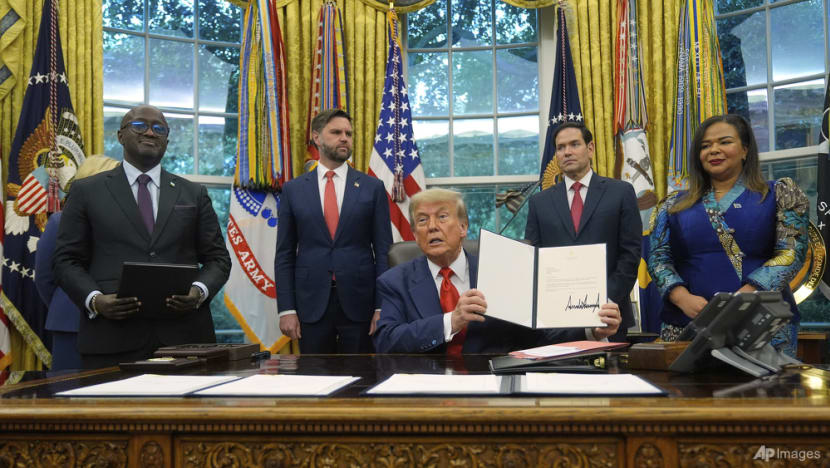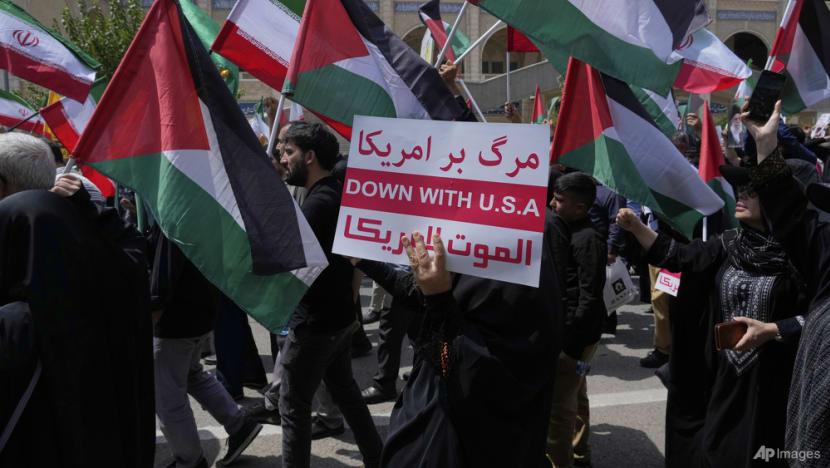Commentary: Trump says ceasefires don’t matter – oh yes, they do
Even the six peace deals he cited as evidence don’t support him, says Marc Champion for Bloomberg Opinion.

President Donald Trump holds up a signed document to present to Congo's Foreign Minister Therese Kayikwamba Wagner, right, as Rwanda's Foreign Minister Olivier Nduhungirehe, from left, Vice President JD Vance and Secretary of State Marco Rubio watch, Jun 27, 2025, in the Oval Office at the White House in Washington. (AP Photo/Manuel Balce Ceneta)
LONDON: Sat beside his Ukrainian counterpart in the White House this week, United States President Donald Trump explained why he’d dropped the idea of trying to pressure Russia into a ceasefire: They’re nice to have, but not necessary, he said – just look at the six wars he’d already ended, none of which involved a preliminary truce.
There are a lot of claims packed in here, so let’s break them down.
It’s true that not all peace agreements are preceded by truces – but a lot are. One study has counted 2,202 ceasefires that quieted conflicts around the globe between 1989 and 2020.
Trump was also right about truces being used not just to help bring an end to the fighting but to actually advance war-fighting strategies.
What ceasefires most certainly aren’t, however, is just “nice to have”. Nor are the six conflicts that Trump claims to have ended any kind of dataset to make that point.
THE SIX WARS DONALD TRUMP CLAIMS TO HAVE ENDED
Trump claims to have ended wars between Armenia and Azerbaijan, Cambodia and Thailand, India and Pakistan, Ethiopia and Egypt, Iran and Israel, and Rwanda and the Democratic Republic of Congo.
Ethiopia and Egypt can be ignored. Those two countries weren’t at war and the dispute over a dam on the Nile that Trump is referring to remains unresolved.
India, meanwhile, says the US wasn’t a party to ending in May the latest of many clashes it’s had with Pakistan since their 1947 partition. If it was, then the deal that emerged was a ceasefire, agreed in a hotline phone call between the two nations’ military chiefs, not a peace settlement. Trump himself called it a “FULL AND IMMEDIATE CEASEFIRE” when claiming responsibility.
The White House can legitimately take credit for using the threat of a trade war to cajole Thailand and Cambodia to the negotiating table, after a long-running border dispute erupted into armed conflict in July. But again, this was a ceasefire. And it led to Malaysia brokering a 13-point settlement the following month. So, a counter to Trump’s argument.
The Armenia-Azerbaijan deal is interesting, but again a poor Exhibit A. The deal became possible, and US involvement was invited, because both countries are currently on the outs with Moscow.
As Thomas de Waal, a Caucasus expert at the Carnegie Endowment for International Peace, told me, Baku and Yerevan especially wanted to free themselves of a clause in their still-operative 2020 ceasefire deal. This had been brokered by Moscow and gave Russia’s Federal Security Service (the former KGB) control over a corridor that passes through Armenian territory, linking Azerbaijan to its exclave, Nakhichevan.
The joint statement that the two nations signed in Washington earlier this month replaced that ceasefire with a final settlement. It also substituted the US for Russia as the corridor’s guarantor. But in terms of Trump’s claims on ending wars, the fighting had stopped in 2023. By the time this US president got involved, there was no fire to cease.
As for Iran-Israel, Trump’s Jun 22 decision to bomb Iranian nuclear facilities clearly helped to dissuade Tehran from continuing its missile exchanges with Israel, but as Yahya Rahim Safavi, an Islamic Revolutionary Guard Corps general and adviser to Supreme Leader Ali Khamenei, said to Iranian media on Aug 17, there isn’t necessarily a peace. “We are not in a ceasefire, we are in a stage of war. No protocol, regulation or agreement has been written between us and the US or Israel,” he said. “I think another war may happen.”

The deal Trump brokered between Rwanda and the Democratic Republic of the Congo in June is probably closest to the US president’s model. The result, however, still doesn’t support his “nice to have” view on ceasefires.
The fighting – much of it conducted by militias and proxies – continues unabated, even after the settlement. The Rwanda-backed M23 group executed 140 DRC civilians in July, part of a monthly total of 300 killed. Despite the Trump-brokered settlement, that made July M23’s most murderous month since 2021, according to Human Rights Watch.
A CEASEFIRE IN UKRAINE WOULD MATTER
Ceasefires can be important for multiple reasons, with their potential to stop the killing and facilitate aid flows topping the list. That’s especially true for conflicts such as Gaza, DRC and Ukraine, where the toll on civilians is unacceptably high.
A close second is that agreement to a truce can indicate whether one or both sides are even interested in ending the war, or if the reason they began fighting remains as compelling to them as ever.
Until about a year ago, for example, Ukrainians were opposed to any ceasefire. Their country had been invaded, and they’d had considerable success in taking back territory that Russian forces initially seized. They thought they could get back more, and the evidence of rape, torture, child abductions and murder they found in liberated towns convinced them this was also a moral duty. A ceasefire would, by contrast, lock in Russia’s occupation, together with its horrors.
Even today, a look at the conflict maps produced by Washington’s Institute for the Study of War show that Ukraine has retaken about as much land as it lost since Russian President Vladimir Putin launched his full invasion on Feb 24, 2022.
But hopes of reclaiming any more have faded. Most Ukrainians now say when polled that they want a ceasefire, even if that means accepting loss of control over occupied territory. It’s Putin who is resisting any truce, because his forces are making daily gains and he thinks he can get more.
This is why Trump’s bilateral summit in Alaska was a strategic disaster for Ukraine and its allies.
For the result was that the US has now abandoned the threat of sanctions and other forms of pressure to get Putin to agree to a ceasefire. This has left him with no reason to stop, let alone end, his invasion, unless it’s as part of a strategy to secure through diplomacy the territories and other war aims he has been unable to win on the battlefield.
So, yes, a ceasefire in Ukraine would matter, enormously.
Getting one is at this point a near-impossible mission, given Putin’s continued appetite for war. But it’s also one that Trump, uniquely, has the leverage and tools to execute, should he ever choose to accept it.
















